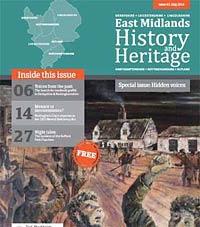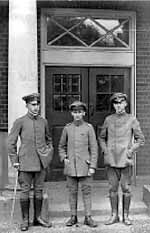News
Geoffrey Bond Research Award 2017

Once again this year we received a number of very good and worthwhile applications for research awards. The selection panel, chaired by John Beckett, decided that this year’s allocation of £2,000 (£1,000 from Geoffrey Bond’s generous grant and £1,000 from Thoroton funds) should be shared between two applicants.
£1,500 has been allocated to Southwell Community Archaeology Group for its community archaeology project to research, compare and document the wall-paintings in the Saracens Head, Southwell, and £500 goes to Bassetlaw Christian Heritage for its project to identify, research and document information on the unique part the Bassetlaw area played in Christian history and which is held in document form in archives and churches, and also orally.
There is a requirement for those receiving grants to provide articles on the outcomes of their research for the Newsletter and, subject to editorial processes, there may be future articles in the Transactions.
We are grateful for Geoffrey Bond’s support in enabling such worthwhile research to be undertaken relating to our county and we look forward to next year’s applications. It is hoped that more individuals and groups will apply for this useful financial support for their research in 2018 and we would urge all researchers to consider whether they could be helped in their endeavours by a grant. The conditions of application are on the Society website at www.thorotonsociety.org.uk/bond-awards.htm
Barbara Cast, Honorary Secretary
Southwell Community Archaeology Group
The group was established in 2008 to bring to public attention the threat by development of the heritage at the former Minster School Church Street. The ‘Save Roman Southwell’ campaign, of which the group was part, has with the generous gift of the land to the Dean & Chapter meant that this threat has lifted. Our engagement with the site continues and we are the link between the Dean & Chapter and the Heritage Trust in matters relating to archaeology.
We are a Charitable Incorporated Organisation and continue to develop professional links in the archaeological community whilst providing a wide range of interesting and enjoyable activities for members. These include small scale test pit excavations, field walking, post excavation work, landscape and other surveying and a programme of talks.
At our recent Archaeology and Heritage event displays and illustrated talks focused on the findings of our HLF funded Burgage Manor Revealed project and other activities we are engaged in. We have produced a book which contains the main points of interest and is available at a cost of £5. [see book review above - Ed]. The afternoon session facilitated by Professor Dixon provided an opportunity for Professor Bowden, Ursilla Spence & Matt Beresford to share their current understanding of the Church Street assemblage.
We continue to record the vernacular buildings of Southwell and have received a Thoroton Society Geoffrey Bond Research Award to study the Elizabethan Wall Paintings at the Saracens Head. A long-term project has been established to better understand Southwell and in its place in the landscape with fieldwalking in the area of the Charter. We continue to have strong links with the University of Nottingham and Nottingham Trent University, Brackenhurst.
With the support of the Dean and Chapter an opportunity has arisen to carry our survey and other archaeological activity on the land comprising Vicars Court. It brings together many professional disciplines and given the Scheduled Ancient monument area extends to part of the land will require the appropriate consents and supervision. Our hope is that this work will lead to a better understanding of the site - the reason for the group’s establishment in 2008.
info@southwellarchaeology.org.uk
https://www.facebook.com/southwellarchaeology/
http://www.southwellarchaeology.org.uk
John Lock
East Midlands History and Heritage

The free publication East Midlands History and Heritage started life in late 2014 as a cross collaboration between several universities in the region. Since then its reach has extended significantly to include all nine local universities, county history societies and key heritage groups. We’ve also had financial support from such organisations as the Friends of the Centre for English Local History, Marc Fitch and, of course, Nottinghamshire’s Thoroton Society. EMHH is a not-for-profit organisation. It’s here to provide a high-quality publishing outlet primarily for local historians, local history and heritage groups, and for post-graduate students. We take articles of between 1,500-2,000 words on any topic from any period, so long as the subject matter has a strong local connection. We try, wherever, possible to offer a regional balance. Recently, we’ve published stories on medieval graffiti in Nottinghamshire and Derbyshire, archaeological field walking in Leicestershire, the nineteenth-century rural poor of Lincolnshire, and, taking us up-to-date, the impact of the 1947 floods, and the development of the East Midlands Airport in the 1960s. Quite frequently, the authors come with special knowledge. David Stewart, a head teacher in a local special needs school, wrote a good piece on the local impact of the Mental Deficiencies Act, 1913. The Lowdham Grange story in latest issue is written by the son of a former officer at the institution. There are specialist articles, too, on source material: Matt Bazley, who works for Northamptonshire Archives, recently wrote a paper on using manorial records to research the impact of the Black Death.
To cover the costs of design and printing we rely on the financial support of our patrons: organisations like Thoroton, although, as you might imagine, we are constantly seeking new sponsors. The magazine is distributed ‘free’ through our local networks: history groups, libraries and archives, and museums. We publish around 8,000 copies of each issue. Where necessary, we offer advice on research and on writing-up, so that the final copy marries with the needs of our target audience. Originally, we’d planned to publish only the first two issues of the magazine in hard copy to establish the brand, and then become a web-based magazine to keep down costs. Two things happened, however, to change this. The first was that the public reaction to the magazine was, and continues to be, extraordinarily positive; the second was the steady growth in affiliation. Feedback, directly or received through our distributors, suggests that we have certainly located a strong demand. This was reflected, not only in complimentary comments on the publication but requests for further copies, and the anticipation of future issues. We were concerned that becoming a web-based distribution would severely curtail the readership. Given that the primary objective is to give greater access to a good quality history of the region, the move to a web-based production was abandoned. That’s why your continuing support is appreciated.
We’d really like to encourage as broad an authorship as possible. Next year, like many publications probably, we’re planning another special to mark the end of the Great War, but instead of stories on the war itself, we would very much like to focus on its subsequent impact. It’s an attempt to try to do something just a little bit different. We thought, for example, about the medical and social impact of the return of disabled soldiers (I know, for example, that there was a severe shortage of artificial eyes). Remembrance might also be a key theme: memorialisation was not limited to Celtic crosses or obelisks, but to buildings: some grand, like Nottingham General’s Nursing Home, and some small, like my local village memorial hall. Bequests, too, formed part of such sites of memory and mourning. Bigger legacies might include thee Homes for Heroes campaign, or the political unrest and settlements that followed 1918. Whatever your interests, we’d encourage you to do is to get involved with this project.
Nick Hayes (editor), Nottingham Trent University
‘Lace Unravelled’
If you haven’t already done so, take a look at the article entitled Lace Unravelled Roadshow in the Nottingham Castle Transformation update for October 2017, and the section in Nottingham Castle Museums & Art Gallery, Behind the Scenes Blog at www.nottinqhamcastle.orq.uk/behind the scenes, entitled Unravelling Nottingham New Lace Project: Lace Unravelled.
There seems to be heightened interest in the historic links between the lace industries of Nottingham and Calais.
Philip Emerson
ANNIVERSARIES: 100 YEARS AGO
The Great Escape - from Sutton Bonington!

German Officers at Sutton Bonington - image courtesy of University of Nottingham
During the centenary commemorations of the First World War, The Times is running a daily column reprinting a war-related activity first covered one hundred years ago. On 26 September 2017 it reproduced a story from 26 September 1917 headed ‘Escape of 23 War Prisoners’. It was about the escape of German officers from the internment camp at Sutton Bonington.
The Times reported the story with a certain sardonic humour. The German POWs had dug a tunnel and collected supplies ready for the break out, but having escaped they then struggled to put much distance between themselves and the camp. Six of them were caught near Nottingham, two were found asleep in a wood ‘worn out by their walk’, and three were arrested when they aroused suspicion by asking the way to the nearest railway station. Captain Muller was caught when schoolchildren found him blackberrying in Tollerton woods, six miles from the camp. Two more were found in East Leake ‘playing at cards while crouching beneath a hedge’.
These two men do not seem to have been trying all that hard to make their way back home, and apparently confessed the whole story. The escapees had tunnelled a distance of 50 yards over a three months period. Having escaped they divided into groups of four and started out on different routes towards the coast ‘where they hoped to get away by tramp steamers’.
Eighteen of those who escaped had been recaptured by 28 September 1917, and four more were taken at Chesterfield by Derby police on 30 September.
The story is, of course, well known. The Midland Agricultural College had been preparing to move from its premises in Kingston on Soar to the main building and men’s hostel newly built at Sutton Bonington. That building had a date stone of 1915. Before the move could take place the buildings were taken over to house German officers, who were generally well treated when they were captured as prisoners of war. In 1915 Sir Arthur Conan Doyle complained that they were quartered well away from ordinary soldiers, often in country houses or in the officers’ quarters of barracks. These were comfortably furnished, and servants were found for them from among the soldiers held as POWs. One of the prisoners, named in The Times, Captain Muller, had been in command of the Emden, a German raiding cruiser which had bombarded Madras in September 1914, and was subsequently sunk off the Cocos Islands on 9 November.
When the Sutton Bonington escape was reported, special constables were called out ‘and every measure was taken to apprehend the escaped prisoners’. With night patrols and road blocks, as well as special constables at strategic points, the prisoners were prevented from making much headway. Lieutenants J. Stadelfaauer and P. Bastgem were recaptured in Derby after a week on the run - perhaps an inappropriate term since they had travelled just twelve miles from Sutton Bonington. Three men caught in West Bridgford on 25 September 1917 had among their possessions sardines, milk, bacon, ham, cheese, prunes, sausages, biscuits and dried toast. They might not have got far in their search for a packet boat to take them to Germany, but they were not going to starve. In fact, in the course of the First World War, only one German officer made it back home.
John Beckett
200 YEARS AGO
On November 24th 1817, a claim was made for 3s. 4d. for ‘Clerk attending this evening at the New Theatre in Bottle Lane, with the Mayor and Alderman Soars, to disperse a Company of Comedians, unlawfully acting a play for hire....
A footnote adds that it was an early ‘little theatre’. ‘A room had been fitted up as a theatre by a number of boys and girls who gave public performances there, with printed bills of fare, in spite of their parents’ disapproval. A passionate love-scene was in progress when the Mayor’s appearance put a stop to the proceedings, and caused great consternation. In view of their youth, the offenders were bound over.’ - Records of the Borough of Nottingham Vol VIII 800-1835
The incident was reported in the Nottingham Journal, November 29th 1817. ‘The parties were in the middle of the fifth act of ‘The Busy Body’ and old Sir Francis Gripe was very lovingly hugging and kissing Miranda when the Mayor appeared and put a stop to their proceedings. The command operated like a thunderclap on all present’
But, did the theatregoers get their money back? [My thanks to Terry Fry for this juicy bit of gossip - Ed]
400 YEARS AGO
‘It was agreed that Richard Bullivant, the Armourer, in respect of his extraordinary pains in dressing and scouring the town’s armour, shall now have twenty shillings yearly wages more be added, to make it up to forty shillings a year, so that, hereafter, he bring no bills to put the town to any further charge about the keeping or scouring thereof’ - Nottingham Date Book.
800 YEARS AGO
The ‘Charter of the Forests’ of King Henry III was issued on 6th November 1217. On 11 February 1225, at the same time as issuing the final and definitive version of Magna Carta, Henry likewise issued a new version of the Charter of the Forests. Thereafter ‘the Charters’, as they were called, were always linked together.
THOROTON RESEARCH GROUP
There were eight members present at the latest meeting of the Research Group, which was held on Saturday 30th September.
The Group discussed two major anniversaries in 2018 (other than the end of the Great War!) which were the Spanish ‘Flu pandemic of 1918-19 and the Representation of the People Act 1918 which gave votes to (some) women for the first time. We were informed that a group at the University of Nottingham were researching the local impact of the Spanish ‘Flu outbreak, and the Nottingham Women’s History Group were carrying out a major piece of work on ‘votes for women’. There was probably little that the Group could contribute, other than looking at the two later, and minor, peaks in influenza in 1924 and 1925, and possibly something on the Women’s Anti-suffrage League. Contributions from members included:
- Elizabeth Robinson described work on the Garden at Bromley House;
- John Wilson talked about the two heliochronometers at Rufford Abbey, one which had been installed in the Rose Garden in 1919 in memory of King Edward VII and the new one (2009);
- John also described a study of the Gibbs family of clock and watch makers of Nottingham and a preliminary investigation of church dedications and patron saints in the east Midlands;
- Andrew Hamilton had ‘discovered’ a large painting of Wollaton Village by Jan Siberechts, dated 1697, at Birdsall House. He discussed the painting in the light of current research into the early Wollaton cottages;
- Keith Fisher described his ongoing work on graffiti on lead roofs;
- Trevor Lewis informed the meeting that 2019 was the 200th anniversary of the opening of the Mansfield to Pinxton Railway. There would be events and an exhibition to commemorate the opening of the railway and its history.
Finally, the Meeting discussed the possibility of having a Thoroton ‘blog’, attached to the Society’s website. [Editor’s note - If we were to have a ‘blog’ on the Thoroton Website, would members read it and contribute to it? Please let John Wilson have your views at wilsonicus@btinternet.com, or see John at a Society meeting.]
Dates for next year’s meetings will be published in the Society’s programme card for 2018.